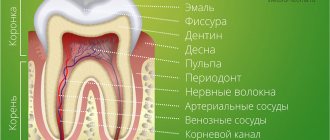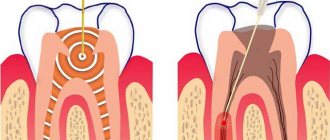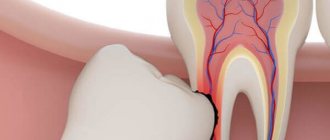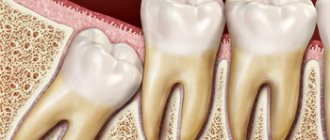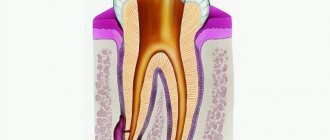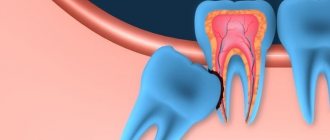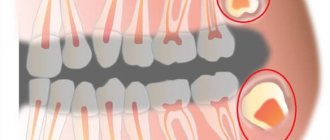Today, anesthesia in dentistry is used everywhere for a variety of procedures, from hygienic cleaning to implantation. An anesthetic injection not only provides comfort to the patient, but also significantly facilitates the doctor’s work.
Read in this article:
- How long does tooth freezing last?
- Treatment and removal - is there a difference in pain relief?
- How long does dental anesthesia last?
- What to do to make dental anesthesia go faster
- 4 tips on how to “freeze off” faster
- What to do if numbness of teeth does not go away after anesthesia
- What's the result?
The anesthetic technique is selected taking into account the type of manipulation and implies a certain exposure time. After administration of the drug, the tissues surrounding the tooth are “frozen” and stop responding to any irritants. Sometimes this lasts much longer than necessary and does not allow you to return to your usual rhythm.
Treatment and removal - is there a difference in pain relief?
There are 3 types of anesthesia most commonly used:
- application;
- infiltration;
- conductor.
Freezing during tooth extraction is mainly conductive, since it turns off large nerve trunks and lasts longer, about several hours. Teeth are treated primarily with infiltration anesthesia, the effect of which lasts from 15 minutes to 1 hour.
Applications are used to perform small procedures, often in children. Local application of Lidocaine 10% can only numb the injection site. Therefore, it can hardly be called freezing.
The type of anesthesia is determined based on which area needs to be numbed. For example, freezing when treating teeth on the upper jaw and in the area of the lower incisors is usually infiltrative: an injection is made into the transitional fold area of the diseased tooth.
Attention!
Infiltration anesthesia can also be used when removing upper or lower anterior teeth. Therefore, sensitivity in these places usually returns faster.
The transitional fold is located on the border of the lower part of the gum and the mobile mucous membrane of the cheek or lip. After administration of the medicine, an infiltrate is formed here - a kind of depot, from which the anesthetic quickly spreads to the jaw bone.
As for conduction anesthesia, it is used not only for removal, but also for treatment, especially of molars. This is due to the properties of the structure of the mandibular bone - it is more dense and voluminous. Moreover, the density and dimensions increase closer to the corners of the jaw.
Types of anesthesia
In modern dentistry, as a rule, two types of anesthesia are used:
- Local.
- Intravenous sedation.
Local anesthetics are the most common treatment for pain relief during dental procedures. They allow you to numb the local area of the oral cavity where the operation will be performed. However, the area of action of such drugs usually affects not only the tooth, but also adjacent tissues. For example, often after the administration of an anesthetic, numbness of the tongue, lips or cheek area appears.
Intravenous sedation is a treatment during sleep, when the patient is half asleep under the influence of drugs. The anesthesiologist carefully selects a prescription regimen taking into account your situation and your tests. It is important to clarify that this is not anesthesia in the form by which we understand it - the operation is carried out in a dental clinic, the patient breathes on his own and a couple of hours after the manipulation can go home; more details about sedation are written here. Indications for treatment under sedation will be:
- Severe fear in adults and children of dental surgery.
- For epilepsy.
- If the procedure takes a long period of time.
- Allergic reactions to topical drugs.
Any type of painkiller loses its effect over time, returning the body to its original state. The duration of action depends on the following factors:
- The nature of the substance.
- Method and correctness of drug administration.
- Individual characteristics of the patient.
- Place of injection.
How long does dental anesthesia last?
On average, the freezing effect lasts 1-2 hours. However, its duration depends on the drug used: for example, injections with Novocaine anesthetize for no more than half an hour, Bupivacaine acts for at least 2 hours. Modern clinics mainly use anesthetics containing Articaine, which freezes tissue for up to 3 hours.
The infiltration anesthesia on the upper jaw will wear off in 45 minutes at most. This is due to the structure of the maxillary bone, which is looser and better supplied with blood.
Freezing after tooth extraction will last longer if the anesthetic contains a vasoconstrictor - a substance that constricts blood vessels and prolongs pain relief.
Indications for general anesthesia
Under general anesthesia in dental practice, it is possible to eliminate almost all problems that arise in the oral cavity - from simple dental caries to complex maxillofacial operations. The patient seeks this type of help, most often, not because of pain, but because of severe fear or medical conditions that interfere with the doctor’s work (allergies, gag reflex, mental illness, etc.). More information about the types of anesthesiological support and how treatment is carried out with switched off consciousness can be found on our website. Here we will talk about the process of postoperative restoration of the patient’s activity , depending on the method of pain relief and the medications administered.
What to do if numbness of teeth does not go away after anesthesia
Lack of sensitivity can last for quite a long time, especially after the removal of difficult wisdom teeth. Sometimes you have to wait 8 or even 9 hours for “defrosting”.
If all the normal deadlines have passed, and the numbness of the gums, tongue or nose does not go away, you should consult a dentist. It is possible that during the manipulations the nerve that is responsible for the innervation of the mucous membranes of the nose or tongue was damaged.
This happens when extracting figure eights with roots that come close to the mandibular nerve trunk. Fortunately, this situation is very rare, occurring in only 0.5% of patients.
But even if you fall into this half a percent, it is fixable. Over time, the nerve recovers and sensitivity returns. The bad news is that sometimes the recovery process takes several months (but no more than six months), and it is impossible to speed it up.
Possible complications after removal
Complications after surgery arise due to violations of doctors’ recommendations. Patients begin to rinse their mouth, go to the bathhouse, play sports, or do not take medications that were prescribed. It is absolutely IMPOSSIBLE to do this for 5 days, because the place where the tooth was located is easily inflamed. Pain after removal is normal. Because the anesthesia wears off and the gums heal. Taking painkillers reduces pain.
Without taking antibiotics, inflammation and suppuration may begin. This situation arises due to the fact that food often accumulates at the end of the gums, which is difficult to remove with a brush, and along with it remain microbes that cause suppuration.
If bleeding occurs after removal, you should press the wound with a cotton pad for 15 minutes. If the bleeding does not stop, you should consult a doctor.
For reference! For high-quality and rapid healing, it is necessary that the wound heals well, so you should not eat hard food for at least 5 days and clean the hole.
What can you eat after wisdom tooth removal?
It is forbidden to put anything in your mouth for two hours after extraction. During this time, a plug of condensed blood is formed and fixed on the socket, which is necessary to protect against the entry of various elements, including pathogens. If you are very thirsty, you can do this through a straw or in small sips.
On the first day, you can drink non-hot drinks and eat liquid porridge, yogurt, and soups. Over the next few days, you should adhere to the following recommendations:
- food must be at a comfortable temperature; hot and too cold food is prohibited, including drinks;
- it is necessary to exclude solid foods that can injure the gums;
- You need to chew food on the side that has not undergone surgery;
- After each dose, you need to rinse your mouth with a warm saline solution;
- If your immune system is weakened, you can take additional multivitamins.
It is better to refuse or limit sweet, spicy foods, alcohol, and carbonated drinks.
Indications for removal of eighth teeth
wisdom teeth
- A pronounced tilt of the figure eight towards the seventh tooth or cheek.
- Hypercementosis (excessive deposition of secondary cement, in which the tooth root thickens and becomes deformed).
- Incomplete eruption of the tooth or its location in the bone (retention).
- Destruction of the crown or roots of the figure eight, as well as neighboring teeth (after injury or caries).
- Granuloma (granulation in the form of cystic sacs with pus located in the periodontium).
- Rotation of the tooth around its axis or horizontal position (dystopia).
- Deformation of the roots (they can bend in every possible way, even twist into a spiral or form an angle of 90°).
- The close location of the roots of the upper eights to the nasal maxillary sinuses.
- In the presence of pericoronitis (an acute inflammatory process in the area of the eruption of the figure eight, accompanied by pain and an increase in ESR in blood tests).
How long does it take to recover from anesthesia?
Time to recover from anesthesia
The time to recover from anesthesia after surgery or after caries treatment differs, although not significantly. This is usually 15-30 minutes from the end of medical procedures to the moment when the patient fully regains consciousness and is able to think clearly, talk and walk. This is explained by the fact that the introduction of modern drugs for general analgesia is very effective and their effect can be stopped very quickly. These substances are also quickly eliminated from the body. Of course, the speed at which the body regains consciousness depends both on the patient’s age, his sensations, his somatic diseases, and on the stage of treatment, the period of his stay in medicated sleep, and the method of administering medications. But in any case, the time after anesthesia in dentistry is very short and the patient leaves the clinic on the same day.
How to rinse your mouth after wisdom tooth removal
The first few hours after extirpation, rinsing is strictly prohibited. This can lead to the natural plug being washed away, exposing the socket and bone. If bacteria penetrate inside, alveolitis or osteomyelitis will develop.
From the second day, carefully, not intensively, rinse your mouth with various antiseptics:
- chlorhexidine;
- miramestin;
- furatsilin;
- diluted potassium permanganate.
At home, you can prepare a solution with salt, soda, and add a few drops of iodine to the water. Herbal decoctions with sage, eucalyptus, chamomile, calendula, and oak bark perfectly relieve swelling and inflammation.
What should I do to make the anesthesia wear off?
The anesthesia will go away faster if you do a massage.
In order to avoid undesirable consequences, you should ask your doctor in advance how to remove the frost after dental treatment.
The specialist should explain that in order for the painkiller to wear off as quickly as possible, you need to follow a few simple rules:
- A few hours before visiting the dentist, it is not recommended to eat heavy food or drink alcohol. Do not take any medicines unless they have been prescribed to you by your doctor.
- In order for the frost to go away faster after a simple dental procedure, it is recommended to drink something warm, as well as massage the numb area.
- After a serious intervention (pulp opening, drainage, etc.), you should not drink or touch this area. Stop drinking for an hour after the intervention, and do not eat food for four to five hours.
After dental treatment, you should not drink for several hours.
If the effect of the painkiller does not go away for a long time, then you need to visit a doctor as soon as possible. It is possible that a nerve was damaged during the intervention. In this case, physical therapy is performed, and a consultation with a neurologist may be required.
Anesthesia in pregnant and lactating women
During pregnancy, dentists do not recommend dental treatment; if possible, this should be postponed until later. However, there are situations in life when it is impossible to tolerate. The most successful period for such manipulations is the second trimester.
But what kind of pain relief should be used during this period? The composition should not contain adrenaline; the patient’s blood pressure should not be allowed to increase, otherwise the uterus will begin to contract.
Dental treatment for pregnant women is not recommended
Important! The drug must be non-toxic; if necessary, the procedure is carried out in a hospital.
There is no danger during lactation, and the doctor can safely use an anesthetic. This anesthesia acts locally, does not penetrate into the blood, and has no toxic effect on the body.
In order to still protect your child, you need to feed him before going to the dentist, and also express milk for the next feeding.
Freezing usually does not last longer than a few hours. If everything was done correctly and the doctor did not make a mistake, then the procedure goes well and the patient does not feel any discomfort.

